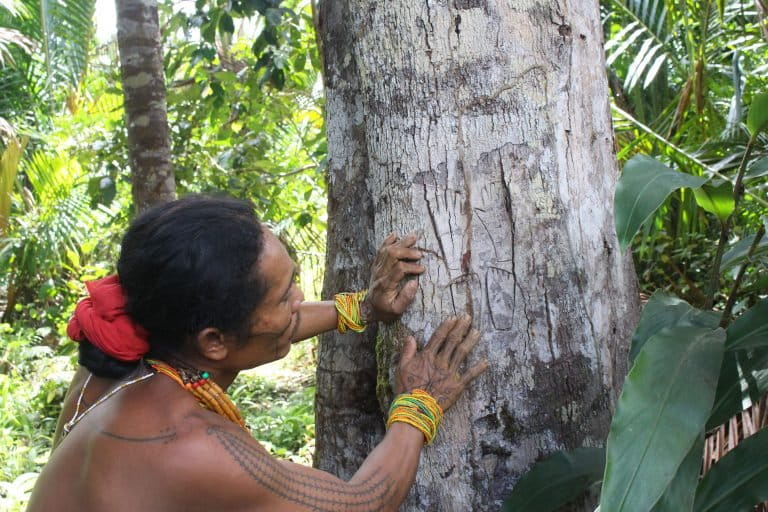- The Mentawai district legislature last month passed a regulation that recognizes the region’s indigenous communities.
- The regulation is the latest in a series of district-level policy moves in the wake of a landmark 2013 Constitutional Court ruling that ended state control over customary lands.
- The move has been hailed as a positive development by advocates for indigenous empowerment, although the pace of progress at the national level remains sluggish.
The indigenous inhabitants of Indonesia’s Mentawai district, a cluster of islands off the southwestern coast of Sumatra, are a step closer to reclaiming their ancestral rights to their land from the state, a development that has been years in the making.
The Mentawai district legislature last month passed a regulation that recognizes the region’s indigenous communities. It is the latest in a series of local regulations issued throughout Indonesia in the wake of a landmark 2013 Constitutional Court ruling that ended state control of indigenous peoples’ customary forests.
That ruling, though, has not been followed up by national legislation to define who qualifies as indigenous and their rights. The lack of legal certainty has left indigenous groups — including, until recently, those of Mentawai — vulnerable to abuse and loss of land to more powerful parties, such as the government and mining and plantation companies.
With the passage of the district regulation, which the Mentawai tribes had campaigned for since 2015, Indonesia has taken another step forward, albeit at the local level, to restore to its indigenous peoples the right to manage their lands and forests.

“We have a rich culture,” said Saibi Samukop Surkino Sanenek, an indigenous Mentawai elder, in response to the passage of the regulation. “We believe that with the regulation we can have a better future and our economy will grow.”
While the district regulation stops short of defining any specific rights or identifying boundaries on customary lands, it has been hailed as a positive development by advocates for indigenous empowerment.
“Related policies at both the national and regional levels must go in line with this regulation,” said Rifai Lubis, a director at the Citra Mandiri Mentawai Foundation, an indigenous people’s advocacy group.
Rifai also called on Mentawai’s 15 indigenous groups — perhaps best-known for their tattooing and teeth-sharpening traditions — to start submitting applications to the government to obtain state recognition of their communities and their rights to customary lands.
The tribes of Mentawai make up a fraction of Indonesia’s indigenous groups, who choose to practice and preserve ancient ways of life that, for the most part, center on the sustainable use of natural resources.
A conservative estimate puts indigenous groups, legally referred to as masyarakat adat, at some 30 million out of Indonesia’s total population of 250 million. The lands to which they have traditionally claimed rights span one-fifth of the country’s total territory of 1.9 million square kilometers (733,600 square miles), according to Indonesia’s main indigenous alliance, AMAN.
President Joko “Jokowi” Widodo, who vowed in his 2014 election campaign to protect the rights of indigenous Indonesians, became the first candidate to ever bag the endorsement of AMAN. But the administration has done little to deliver on the lofty promises since.
It took until December 2016, more than two years into Jokowi’s first term in office, before the president recognized for the first time the rights of nine indigenous communities to their forests. The move came as AMAN was considering rescinding its support of the president, and was followed nearly a year later, in October this year, with the recognition of land rights for nine more tribes.

To date, the administration has restored the rights to just 164 square kilometers (63 square miles) of land to indigenous communities, drawing criticism over the glacial pace of progress on the issue. AMAN is campaigning alongside 55 indigenous communities across the country to reclaim rights from the state to more than 6,600 square kilometers (2,548 square miles) of customary lands.
On the legislative side, AMAN and others are lobbying lawmakers in Jakarta to pass a long-awaited national bill on indigenous rights, but progress here, too, is slow.
In the meantime, advocates have focused on advancing indigenous rights recognition at the regional level, district by district, as in the case of Mentawai.
Since the 2013 Constitutional Court ruling, 78 regional regulations on indigenous communities have been passed, according to AMAN. But the group argues that only 44 of these regulations actually help advance the movement to secure land rights for indigenous communities, while the rest may in fact benefit other groups with vested interests.
“For the indigenous communities, these regional regulations are part of a transition process toward the passing of the indigenous rights bill” at the national level, said Arman Mohammed, a legal researcher with AMAN.
“Recognizing the rights of indigenous communities is [part of the] progress in maintaining diversity and unity in Indonesia,” he added.
FEEDBACK: Use this form to send a message to the author of this post. If you want to post a public comment, you can do that at the bottom of the page.